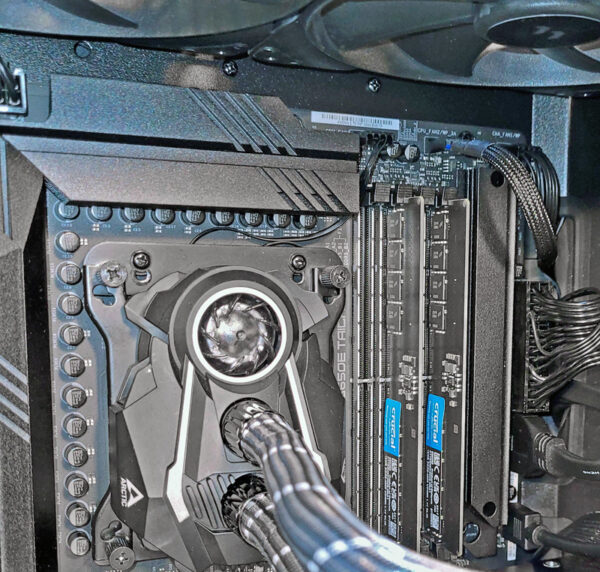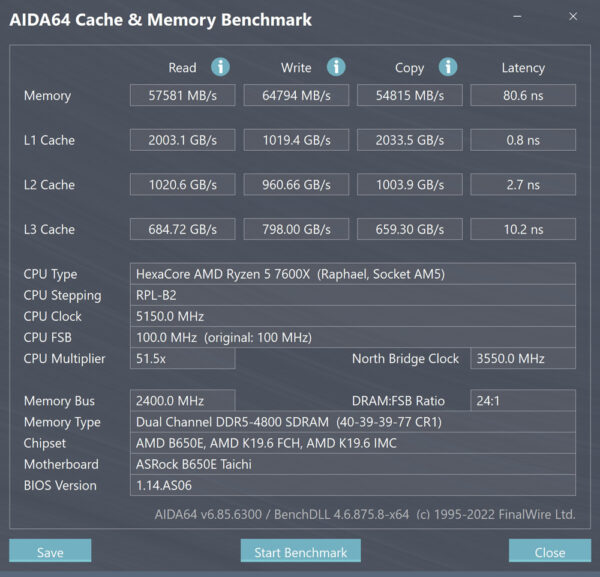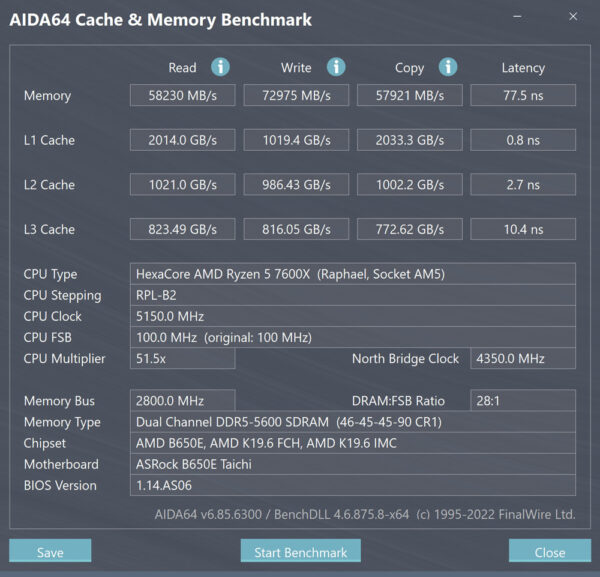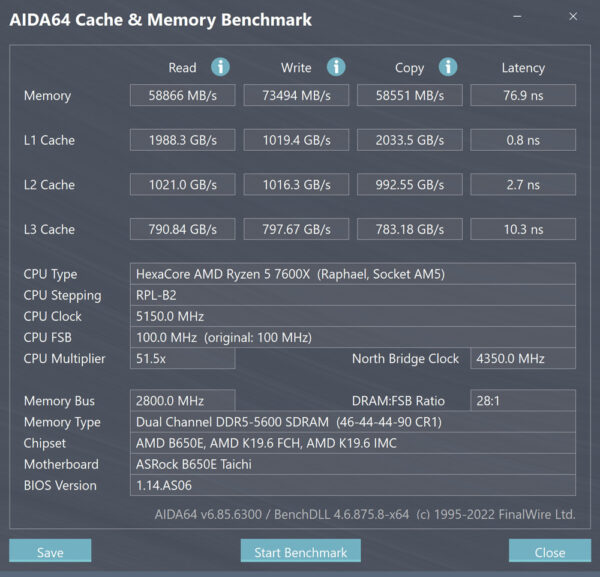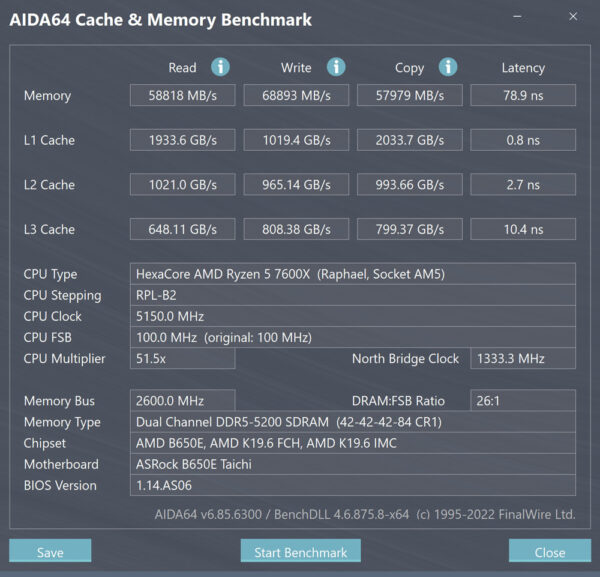
Setup and test results …
Quickly get to the right benchmark results …
Test system
Settings
Default DDR5-4800
DDR5-5600 Auto
DDR5-5600 XMP/EXPO
Summary of the test results
Test system …
We tested the 32 GB Crucial DDR5-5600 memory kit on the following AMD test system.
| CPU | AMD Ryzen 5 7600X |
| Motherboard | ASRock B650E Taichi |
| Cooling | Arctic Liquid Freezer II 360 |
| Thermal compound | Arctic MX-6 |
| RAM | 2x 16GB Crucial DDR5-5600 in Dualchannel mode |
| Graphics card | ASUS TUF RX 6800 XT |
| M.2 SSD | Crucial P5 Plus 1TB PCIe Gen 4 |
| 2,5″ SSD | 2,5″ SSD |
| PSU | Cooler Master Reactor Gold 750 |
We read out the complete memory timings with the Windows tool ZenTimings 1.2.9 and the cache and memory benchmark from AIDA64 Engineer served us to determine the memory throughput and latencies. The CPU score of the 3D Mark Time Spy benchmark provides information about the gaming performance of CPU and RAM. If you want to benchmark your PC yourself and compare it with our values, you can find many useful test and benchmark programs in our OC software collection.
Settings …
In order to keep the following values as comparable as possible, FCLK was always run at 2000 MHz in the BIOS of our test system. Every AMD Ryzen 7000 system should be able to reach this value without problems. Furthermore, UCLK was always run 1:1 with MCLK, so UCLK=MCLK and “AGESA Default” was always used as the DRAM performance mode, which corresponds to the standard.
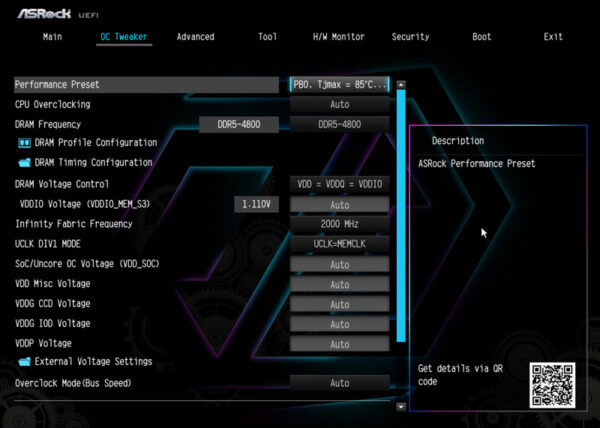
Default DDR5-4800 …
Before we install the 5600 modules in our test system, we determine the initial values with the 4800 memory. These are the timings of the Crucial DDR5-4800 CL40 modules.
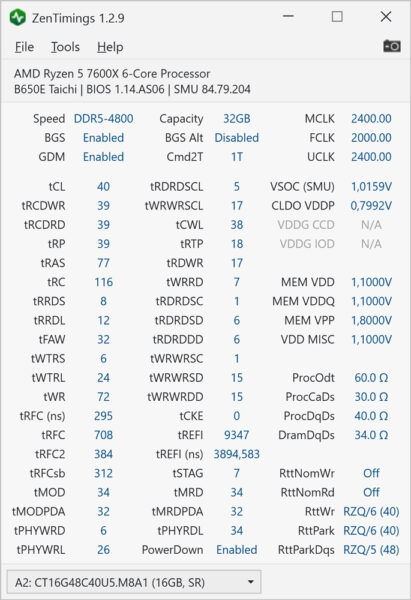
The AIDA Cache & Memory Benchmark provides the following results with DDR5-4800 (2400MHz).
| Frequency | Timing | Memory voltage | Memory read throughput | Memory write throughput | Memory Latency |
| 2400 MHz | 40-39-39-77 | 1.1 Volt | 57581 MB/s | 64794 MB/s | 80.6 ns |
In the 3D Mark Time Spy CPU test, our test system with Ryzen 7600X CPU and DDR5-4800 memory achieved 9544 points.
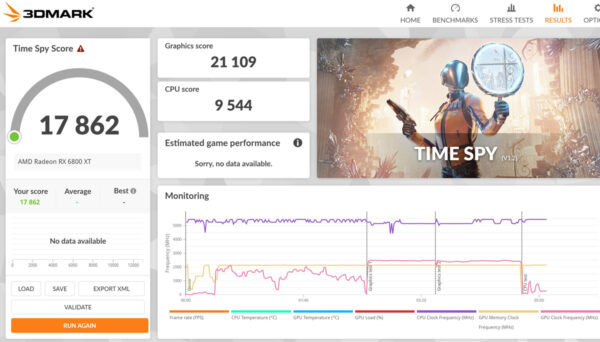
DDR5-5600 Auto …
Next, we look at the benchmark values achieved with the DDR5-5600 modules when they are only inserted into the motherboard and all memory-related values in the BIOS remain untouched at the default setting “Auto”. Thus, no XMP or EXPO profile is loaded. The memory timings were set by our ASRock B650E Taichi as follows.

With DDR5-5600 Auto settings, the AIDA Cache & Memory Benchmark delivers the following results.
| Frequency | Timing | Memory voltage | Memory read throughput | Memory write throughput | Memory Latency |
| 2800 MHz | 46-45-45-90 | 1.1 Volt | 58230 MB/s | 72975 MB/s | 77.5 ns |
In the 3D Mark Time Spy CPU test, 9821 points were achieved with DDR5-5600 Auto Settings.
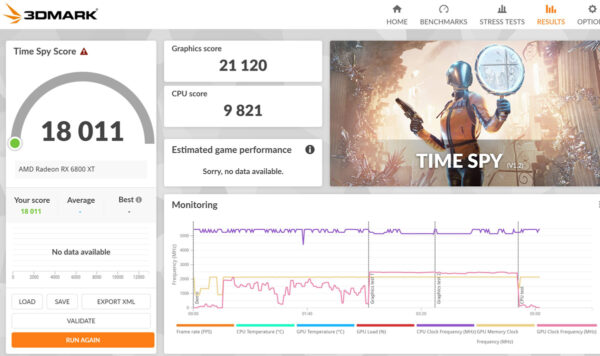
The change from DDR5-4800 to DDR5-5600 already led to an improvement in performance in all tests without adjustments in the BIOS. Next, we will check how much additional performance loading the XMP/ EXPO profiles brings.
DDR5-5600 XMP/EXPO …
We summarize the test results with a loaded XMP or EXPO memory profile, since the values do not differ. Only a single value of the sub-timings differs between the two performance profiles. The only striking difference is the memory voltage. This is 1.2V in the AMD EXPO profile and 1.1V in the XMP profile. Crucial apparently plays it safe with the EXPO profile and raises the voltage by 0.1V, although the kit is actually specified with 1.1V. Apart from a virtually unmeasurable increase in power consumption, an operating voltage of 1.2V has no relevant effects with DDR5. Both the XMP profile and the EXPO profile ran absolutely smoothly on our AMD Ryzen 7600X test system.
These are the memory timings with the Crucial DDR5-5600 modules and enabled XMP/EXPO profile.
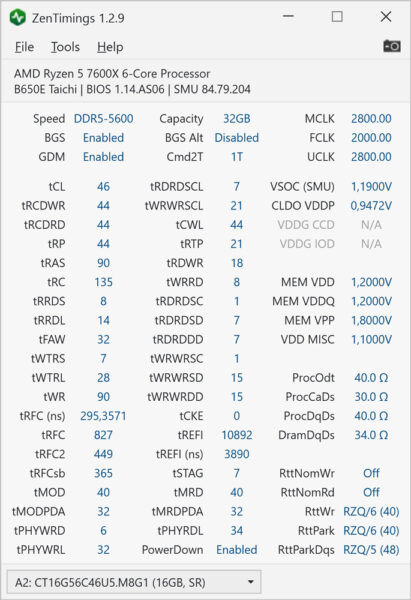
With DDR5-5600 XMP/EXPO settings, the AIDA Cache & Memory Benchmark delivers the following results.
| Frequency | Timing | Memory voltage | Memory read throughput | Memory write throughput | Memory Latency |
| 2800 MHz | 46-44-44-90 | 1.1 Volt | 58866 MB/s | 73494 MB/s | 76.9 ns |
The 3D Mark Time Spy CPU test result reaches 9830 points with the XMP/EXPO profile enabled.
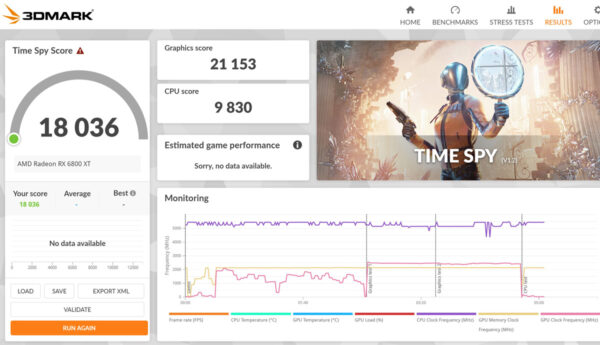
Finally, we will take a look at one of the additional profiles that is stored on the Crucial DDR5-5600 modules. It corresponds to the average value between DDR5-4800 CL40 and DDR5-5600 CL46 in terms of clock frequency and timings, namely DDR5-5200 CL42. The following measurements show us whether this profile is perhaps the golden mean. These are the complete timings from the DDR5-5200 setting.
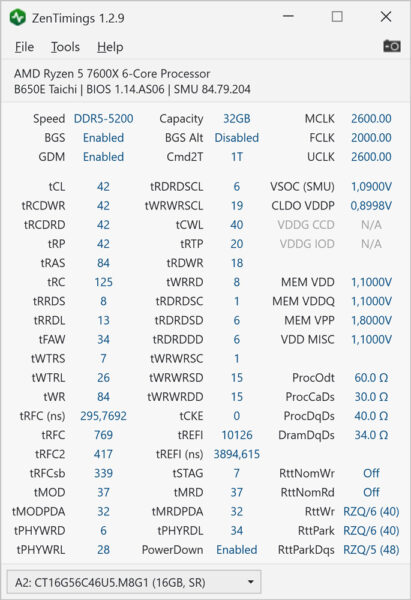
With DDR5-5200 XMP/EXPO settings, the AIDA Cache & Memory Benchmark delivers the following results.
| Frequency | Timing | Memory voltage | Memory read throughput | Memory write throughput | Memory Latency |
| 2600 MHz | 42-42-42-84 | 1.1 Volt | 58818 MB/s | 68893 MB/s | 78.9 ns |
The 3D Mark Time Spy CPU test result reaches 9515 points with DDR5-5200 CL42.
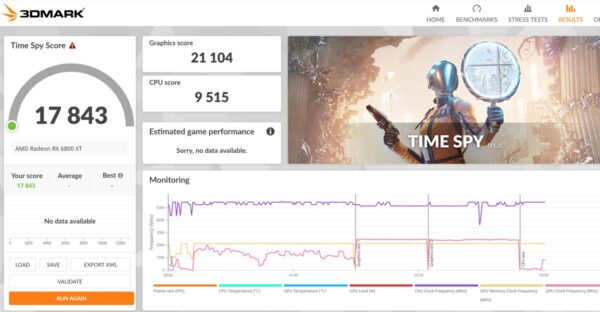
Summary of the test results …
For a better overview, we summarize all test results once again in a comparison table.
| Setting | Frequency | Timing | Memory voltage | Memory read throughput | Memory write throughput | Memory Latency | Time Spy CPU |
| DDR5-4800 CL40 | 2400 MHz | 40-39-39-77 | 1.1 Volt | 57581 MB/s | 64794 MB/s | 80.6 ns | 9544 Pkt. | DDR5-5600 CL46 Auto | 2800 MHz | 46-45-45-90 | 1.1 Volt | 58230 MB/s | 72975 MB/s | 77.5 ns | 9821 Pkt. | DDR5-5600 CL46 XMP/EXPO | 2800 MHz | 46-44-44-90 | 1.1 Volt | 58866 MB/s | 73494 MB/s | 76.9 ns | 9830 Pkt. | DDR5-5200 CL42 | 2600 MHz | 42-42-42-84 | 1.1 Volt | 58818 MB/s | 68893 MB/s | 78.9 ns | 9515 Pkt. |
The DDR5-5600 readings already show an increase in performance compared to DDR5-4800 without manual intervention in the BIOS, both in the pure memory throughput values as well as in the memory latency. The gaming benchmark also increases noticeably. Loading the DDR5-5600 XMP or EXPO profile then brings a minimal improvement in the test results, but with increases of 0.7 to 1% compared to the standard values, the additional gain is manageable. At least this means that you don’t have to accept a noticeable performance loss if you don’t dare to make settings in the BIOS or the motherboard doesn’t even offer the possibility to load memory profiles. The additional DDR5-5200 profiles are still between DDR-4800 and DDR5-5600 in terms of throughput, but disappoint in the gaming benchmark with a worse value than DDR5-4800.
The DRAM performance modes “Competitive” and “Aggressive” could unfortunately not be used with the Crucial DDR5-5600 modules because they immediately led to system instabilities or even made booting the PC impossible. Thus, no further performance increase could be achieved without much effort.
Finally, the Crucial DDR5-5600 modules achieved an increase of only 2.2% in read throughput compared to DDR5-4800. The result looks better in write throughput, which recorded an increase of a good 13.4%. The equally important memory latency decreased by 4.6%, which is especially important for gaming, since the 3D Mark Time Spy CPU test score also increased by 3%.
Crucial 32GB DDR5 2x16GB DDR5-5600 result and general impression …


